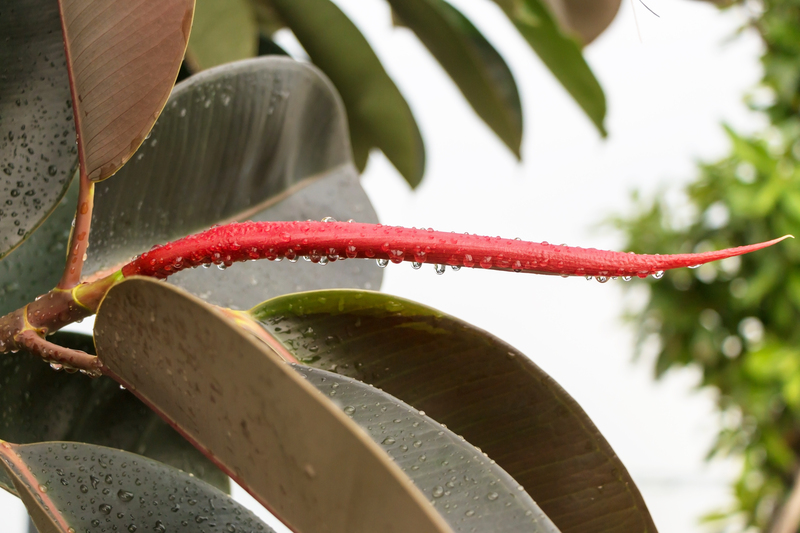Valuable Orchid Care Practices for New Growers
Posted on 11/06/2025
Valuable Orchid Care Practices for New Growers
Orchids are renowned for their breathtaking beauty and intriguing diversity, making them highly sought-after additions to any indoor or outdoor plant collection. For beginner orchid growers, caring for these exotic plants may seem intimidating or complex. However, by following tried-and-true orchid care techniques and understanding their unique needs, even new enthusiasts can achieve thriving, flowering plants. In this article, we'll explore the best orchid care practices that will help you nurture healthy, beautiful orchids from the very start.
Why Orchids Need Special Care
Orchids are not your average houseplants. Originating from diverse environments--from humid rainforests to arid mountains--they have adapted specialized survival strategies. It's important to recognize that orchids often have needs that differ significantly from other potted plants, particularly regarding light, water, and substrate.
- Epiphytic orchids (such as Phalaenopsis, Cattleya, and Dendrobium) attach themselves to trees in their native habitats and draw nutrients and moisture from the air and rainfall.
- Terrestrial orchids (such as Paphiopedilum and Cymbidium) grow in soil but still require excellent drainage and aeration.
Adopting the right orchid care methods will significantly increase your chances of enjoying frequent blooms and vigorous growth.

Choosing the Right Orchid for Beginners
If you're new to orchid cultivation, it's prudent to start with varieties that are considered easy to grow and forgiving of minor mistakes. Here are some excellent starter orchids:
- Phalaenopsis (Moth Orchid): Known for its long-lasting blooms and resilience, it thrives indoors and adapts well to typical home environments.
- Cattleya: Famous for large, fragrant flowers and adaptability to different light strengths.
- Dendrobium: Contains many species and hybrids suitable for indoor growing; prefers bright, indirect light.
- Paphiopedilum (Lady Slipper Orchid): Features attractive foliage and unique blooms, perfect for windowsill growing.
Understanding Orchid Light Requirements
Light is a key factor that influences orchid health and flowering. Too little light results in lush leaves but few or no flowers, while too much can cause scorching.
How Much Light Do Orchids Need?
Most orchids thrive in bright, indirect light. A windowsill with filtered sunlight or a shaded area that receives plenty of ambient light is ideal.
- Phalaenopsis orchids prefer low to moderate light, making them ideal for east or north-facing windows.
- Cattleya and Dendrobium orchids require more light and do well in south or west-facing windows, protected from intense midday sun.
*Tip: If leaves are dark green, your orchid probably needs more light. Yellowish-green leaves may indicate too much light.
Best Watering Practices for Orchids
One of the most common mistakes for new orchid owners is overwatering, which may cause root rot and plant decline.
How Often Should You Water Orchids?
- Check the potting media with your finger; water only when the top 1-2 inches are dry.
- Frequency typically ranges from once every 7-10 days, but can vary with orchid type, pot size, and environment.
- Always use tepid, non-chlorinated water and let it drain completely.
- Avoid letting orchids sit in standing water, which will suffocate roots.
*Tip: If your orchid's pseudobulbs (thickened stems) start to shrivel or leaves wrinkle, it might need more water. However, soggy, mushy roots indicate overwatering.
Humidity and Air Circulation
Orchids often originate from humid environments and benefit from raised humidity levels--especially in dry, heated homes.
- Ideal humidity: 40-70% is optimal for most orchids.
- Use a humidity tray or room humidifier to increase moisture in the air.
- Mist leaves regularly, but avoid letting water settle in the crown or leaves, which can cause rot.
- Ensure gentle air movement with a fan to prevent fungal diseases and aid evaporation.
Choosing Orchid Potting Mix and Containers
Unlike most houseplants, orchids need a light, well-aerated growing medium that allows roots to breathe.
- Epiphytic orchids thrive in bark-based mixes containing pine bark, coconut husk, charcoal, and perlite.
- Terrestrial orchids do well in mixes formulated with finer texture, such as peat, sphagnum moss, and leaf mold.
- Select pots with drainage holes--clear plastic pots are a favorite as they permit you to monitor root health and moisture.
*Tip: Repot orchids every 1-2 years or when the potting mix starts breaking down to ensure roots remain healthy and oxygenated.
Feeding Your Orchid - Proper Fertilizing Techniques
Orchids are light feeders compared to some other houseplants. However, correct, balanced fertilizing is essential for vigorous growth and abundant blooms.
- Use a balanced orchid fertilizer (20-20-20 or similar) diluted to quarter to half strength.
- Feed every 2-4 weeks during active growth (spring and summer); reduce frequency in fall and winter.
- Flush the pot with clean water monthly to prevent salt accumulation which can damage roots.
*Tip: The motto "weakly, weekly" is popular in the orchid community--err on the side of less fertilizer, rather than more.
Temperature Requirements for Orchids
Each orchid species has its own temperature preferences, but broadly:
- Phalaenopsis: Prefers 65-80?F (18-27?C) during the day, with a minimum of 60?F (16?C) at night.
- Cattleya & Dendrobium: Prefer daytime temperatures of 70-85?F (21-29?C) and nighttime temps 55-60?F (13-16?C).
- Most orchids benefit from a 10-15?F temperature drop at night to stimulate flowering.
*Tip: If kept indoors, placing orchids near a window can create the temperature fluctuations they need (but beware of cold drafts in winter).
Recognizing and Managing Orchid Pests and Diseases
Vigilance is the best defense against orchid pests and diseases. Common problems for new growers include:
- Mealybugs, scale, and spider mites: Present as fluffy white patches, bumps, or fine webbing. Remove by dabbing affected areas with alcohol or using gentle insecticidal soap.
- Fungal and bacterial diseases: Soft, dark spots or mushy leaves often result from excess moisture or poor air flow. Remove affected tissue and adjust care conditions.
- Root rot: Caused by overwatering or using the wrong potting medium. Repot immediately in fresh mix and trim any damaged roots.
*Tip: Isolate new orchids for a few weeks before introducing them to a collection to prevent potential spread of pests.
Encouraging Your Orchid to Bloom
For rookie orchid growers, waiting for the first *breathtaking blooms* can test your patience. Here's how you can prompt your orchid to flower:
- Ensure your plant is mature (many species won't bloom until 2-3 years old).
- Provide ample indirect light--lack of light is a frequent cause of non-flowering orchids.
- Follow a strict watering and feeding regimen, without letting the orchid remain wet for prolonged periods.
- Allow for natural day-night temperature drops to trigger spikes in flower production.
Bloom Aftercare
After your orchid finishes blooming:
- Phalaenopsis: You may trim the flower spike back to a node to prompt a secondary bloom, or cut it off entirely to allow the plant to rest.
- For other orchids, cut the spent flower stalk at the base to redirect energy to new growth.
- Resume regular care--avoid fertilizing heavily when the plant is resting.
Common Mistakes New Orchid Growers Should Avoid
Learning from others' experiences can save you frustration and disappointment. Here's what to watch out for as a novice orchid enthusiast:
- Overwatering: The top killer of orchids. Always check that roots are not sitting in soggy media.
- Poor lighting: Insufficient light means no blooms, while direct sun causes scorched leaves.
- Ignoring repotting needs: Orchids outgrow pots and require fresh media to thrive.
- Improper potting mix: Standard potting soil suffocates roots--always use orchid-specific mixes.
- Too much fertilizer: Orchid roots are sensitive to chemical burn.
- Neglecting air circulation: Stagnant air encourages pests and fungal disease.

Valuable Tips for New Orchid Enthusiasts
- Label each plant--different species have different care needs.
- Observe your plant regularly; healthy roots are silvery-white or green and firm to the touch.
- Join online communities or local orchid societies for support and inspiration.
- Be patient--growth and flowering can take time, but the rewards are worth it.
Conclusion: Growing Orchids Successfully as a Beginner
With proper orchid care practices and a little patience, even novice orchid growers can achieve dazzling results. By understanding your orchid's specific requirements--light, water, humidity, and nutrients--you'll ensure a healthy plant likely to produce breathtaking flowers year after year. Remember, each orchid is unique, so observe, adjust, and enjoy the rewarding journey that is orchid cultivation.
Frequently Asked Questions for New Orchid Growers
- How do I know when to repot my orchid?
Repot when roots spill over the edge, the potting medium breaks down, or drainage is poor--usually every 1-2 years. - Can I put my orchid outside?
Most orchids can be moved outdoors in warm, humid, shaded areas during summer but should be protected from direct sun and temperature extremes. - Do orchids go dormant?
Some species, such as certain Dendrobiums or Cattleyas, rest after flowering. Reduce watering and let them rest until new growth appears. - Is misting necessary?
Misting helps boost humidity, but do it cautiously to avoid water pooling on leaves, which can cause rot. - Why are the leaves on my orchid wrinkling?
This often signals dehydration--adjust watering, check roots, and boost humidity.
Armed with these valuable orchid care practices, your journey as a new orchid grower can be full of success and satisfaction. Happy growing!

